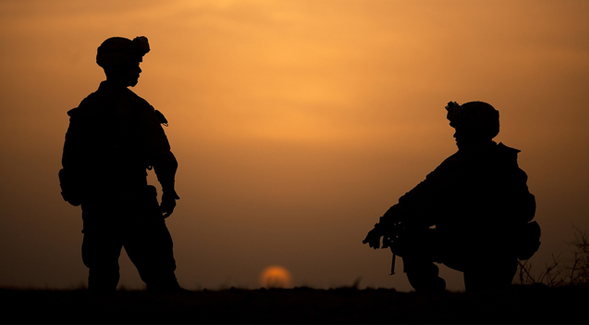Study Finds Post-9/11 Combat Service Negatively Impacts Veterans Education
New research suggests that combat exposure results in reduced likelihood of attaining a four-year degree.

San Diego State University economics professor Joseph J. Sabia and U.S. Military Academy economics professor William Skimmyhorn found that today’s combat veterans rely more heavily on disability compensation and are far less likely to pursue a college degree than comparable soldiers not assigned to combat.
Sabia and Skimmyhorn’s findings, detailed in “War! What Is It Good For? The Effects of Combat Service on Economic Transitions of Veterans,” will be published in the forthcoming issue of the Economic Self-Sufficiency Policy Research Institute Working Paper Series.
This new work is the first known study to use U.S. Army administrative data to examine the economic impacts of combat exposure in the Global War on Terrorism.
The researchers sought to fill a gap in the existing literature about how post-9/11 warfare is impacting the economic transitions of new veterans. Sabia and Skimmyhorn researched how unit-level combat exposure affected the ease with which veterans could reconnect with civilian life through participation in the workforce and pursuit of college and university degrees.
Focusing on a dataset consisting of veterans who separated from the U.S. Army between 2001 and 2016, Sabia and Skimmyhorn analyzed the socioeconomic well-being of roughly one million soldiers, including their use of veteran disability compensation benefits, unemployment insurance, educational benefits under the post-9/11 GI Bill and educational attainment.
“Uncovering the labor market effects of Global War On Terrorism-era combat service is critical, not only to better assess the full social cost of recent conflicts, but also to inform policymakers as they design effective transition assistance programs for separating service members,” Sabia said.
Sabia and Skimmyhorn found that combat service generates adverse socioeconomic consequences for veterans, such as increased reliance on unemployment insurance and disability compensation, which often generate disincentives for economically self-sufficient transition. Moreover, the adverse physical and psychological effects of combat may also impede successful transitions, they explained.
Combat deployments substantially increase veterans’ reliance on disability compensation benefits for post-traumatic stress disorder (PTSD) and traumatic brain injury (TBI). These impacts are exacerbated by soldiers’ exposure to injuries and deaths among members of their units, the researchers explained.
“The magnitudes of these effects are large and, coupled with the lifetime cost of treating PTSD and TBI, create substantial additional medical costs for taxpayers. Back-of-the-envelope estimates suggest the additional costs of PTSD and TBI to be almost $40 billion and $20 billion, respectively,” Sabia said.
In addition, combat deployments result in important adverse schooling effects.
Those assigned to combat for 18 months or longer are 20-35 percent less likely to pursue a post-secondary degree during their enlistment and 4-10 percent less likely to obtain a four-year college degree following separation, the researchers found.
Sabia and Skimmyhorn noted that the unemployment and disability rates of veterans of recent wars in Afghanistan and Iraq, who are entering the civilian labor force at a steady rate, exceed those for veterans of all wars.
Sabia explained that the first year after discharge, separation, or retirement from the military is especially crucial to help remedy some of the challenges service members face.
“Identifying at-risk veterans is critical for the successful implementation of Executive Order 13822,” Sabia said, referencing the mandate issued by U.S. President Donald Trump designed to improve mental health services provided to new veterans.
“The results of our study suggest that it may be important to enable specialized training for those exposed to combat and better tailor services offered to those in warrior transition units,” Sabia said. Examples include providing specialized and tailored psychological support services, interview preparation and career-building support.
“Finally, our findings could suggest additional services and remediation efforts while individuals are still in service. They also may provide a rationale for additional compensation for combat veterans,” Sabia said.



